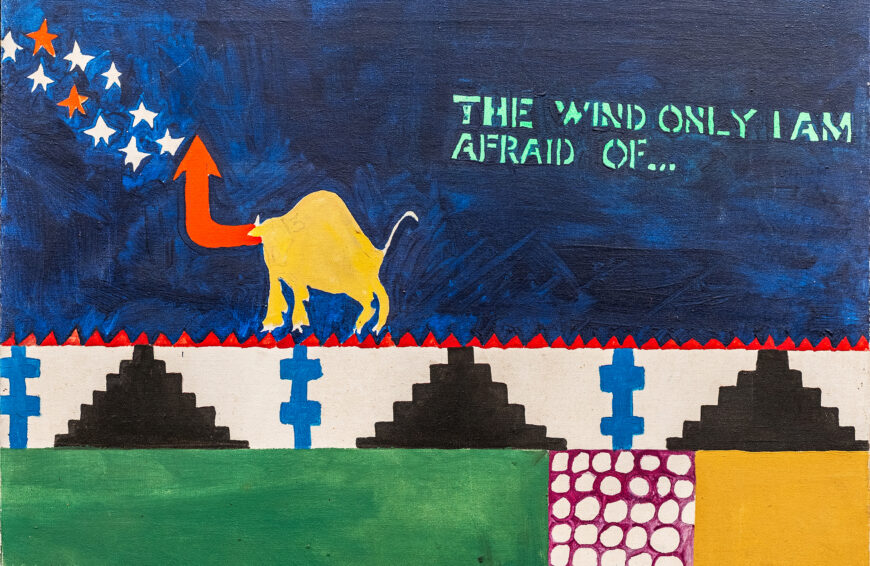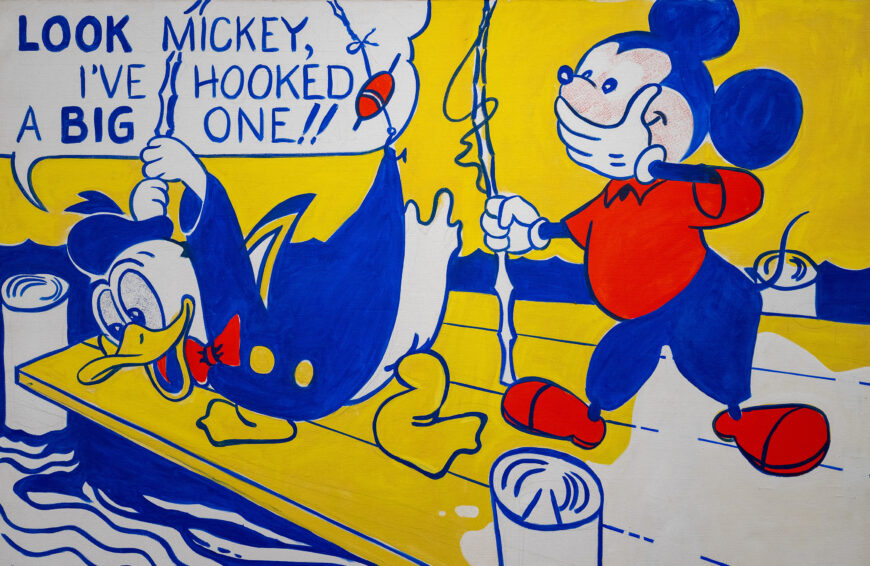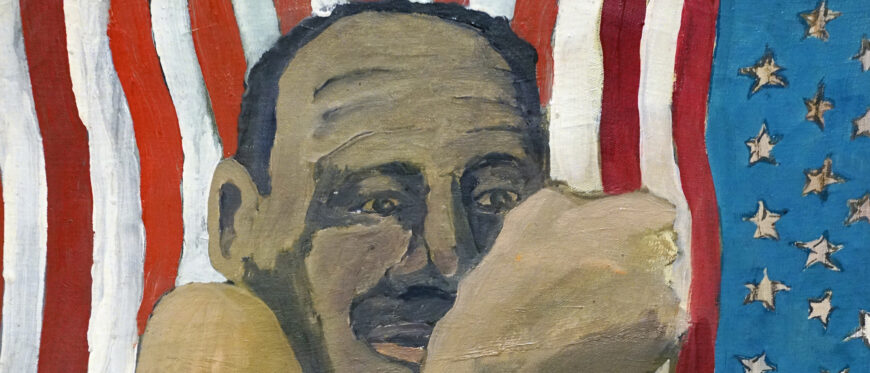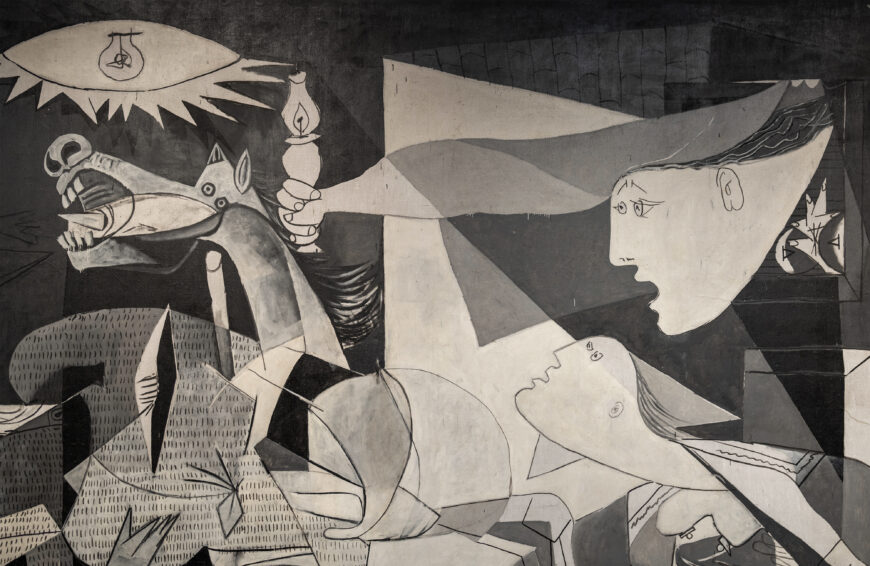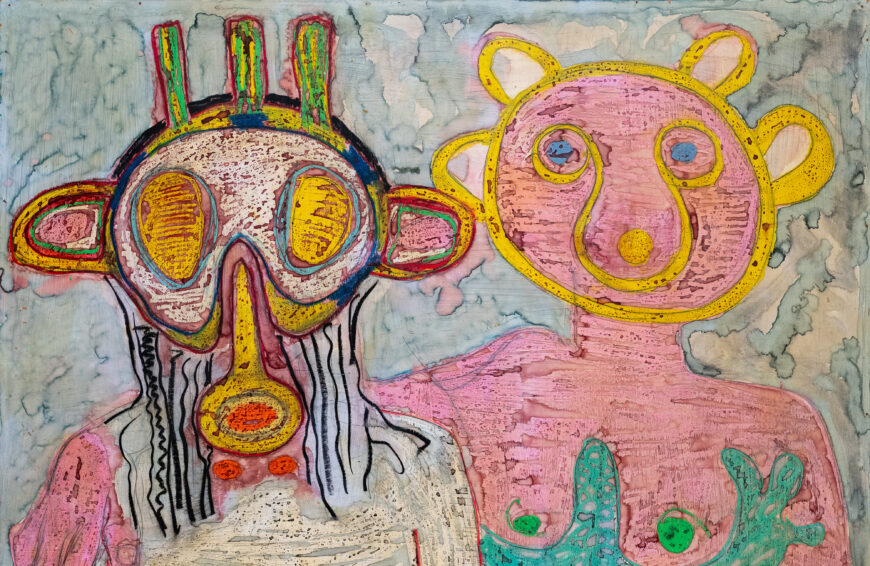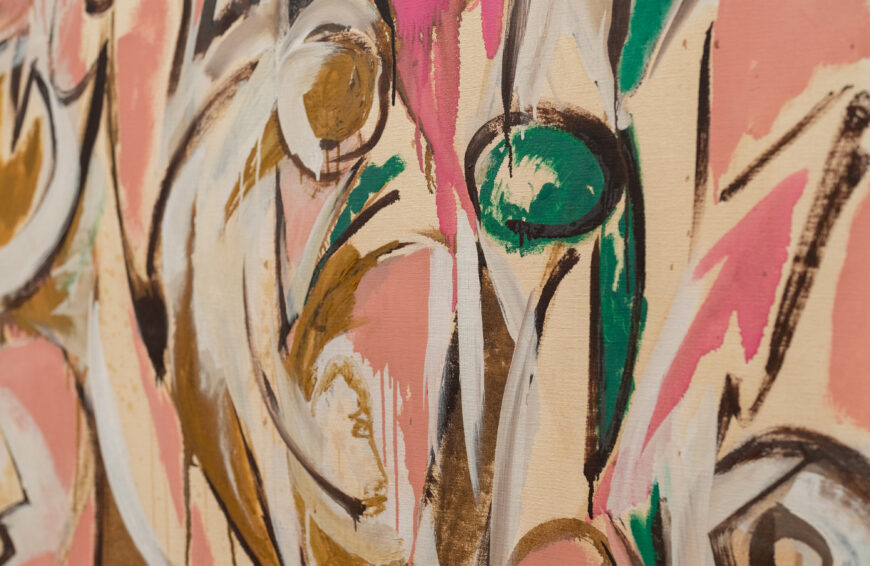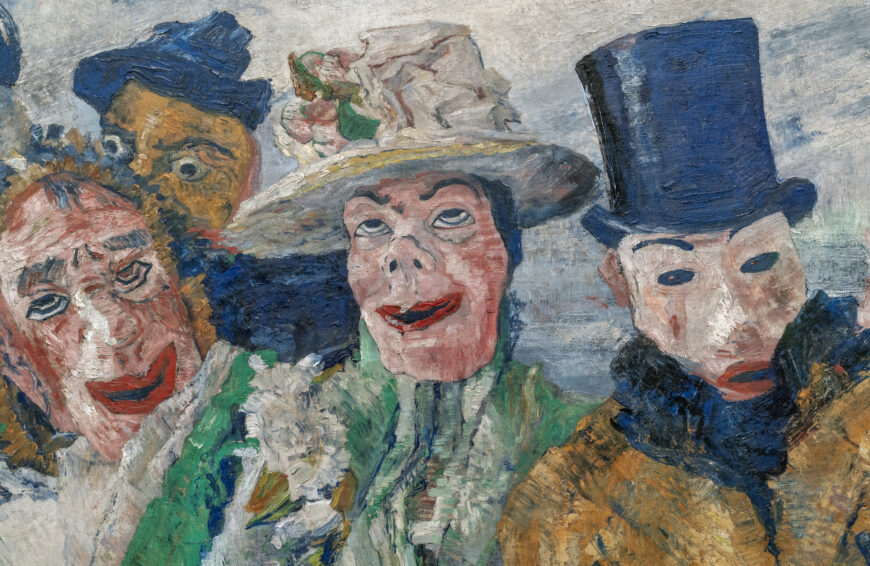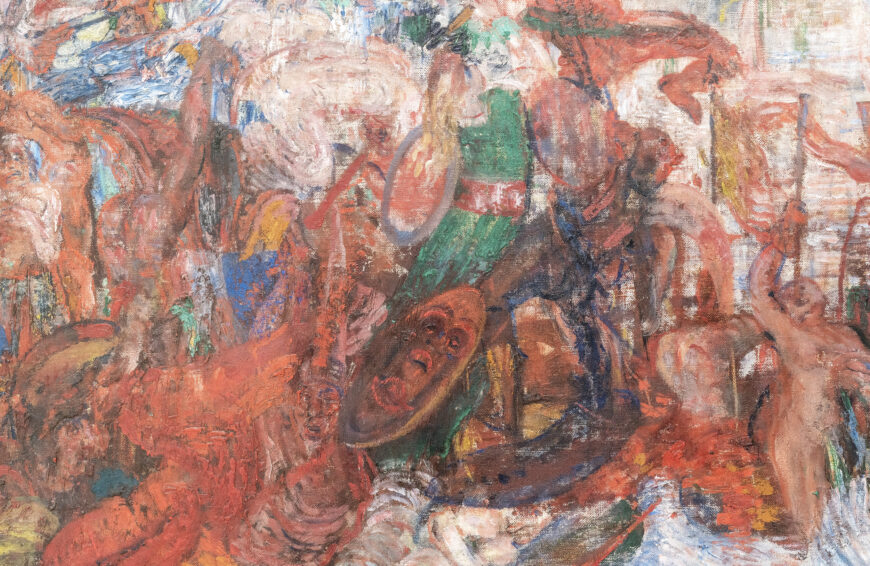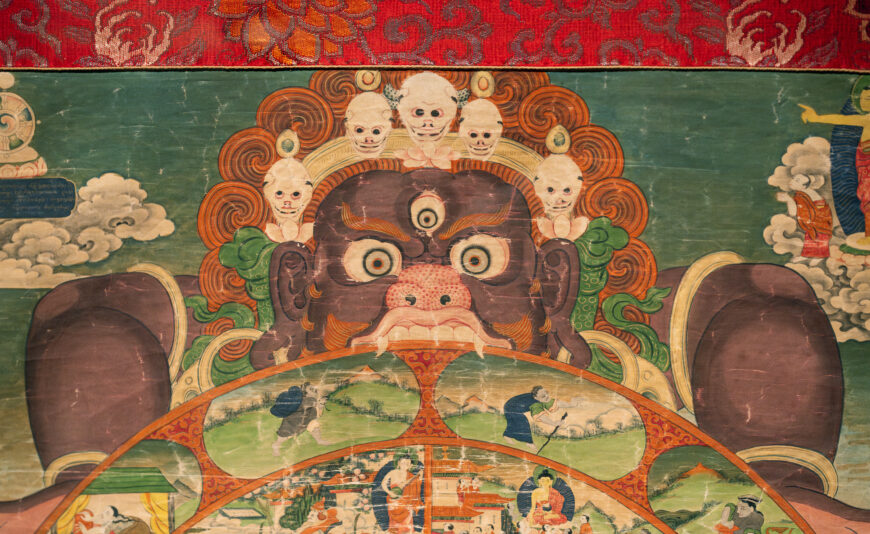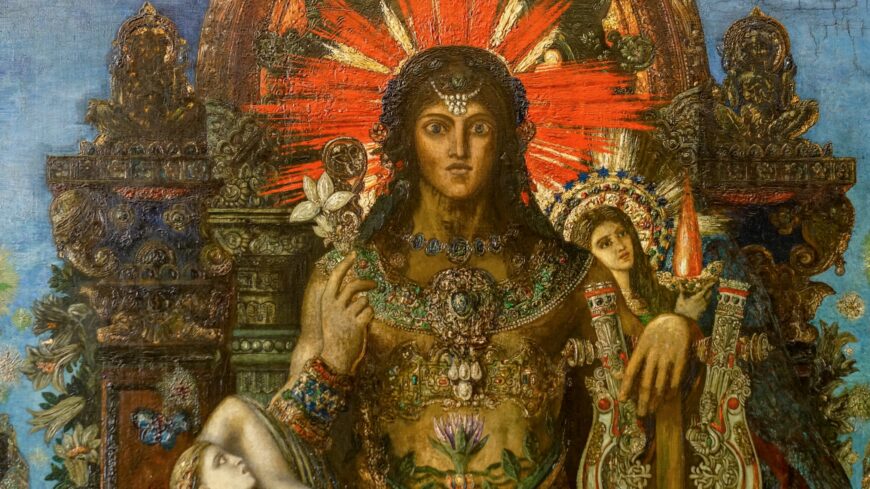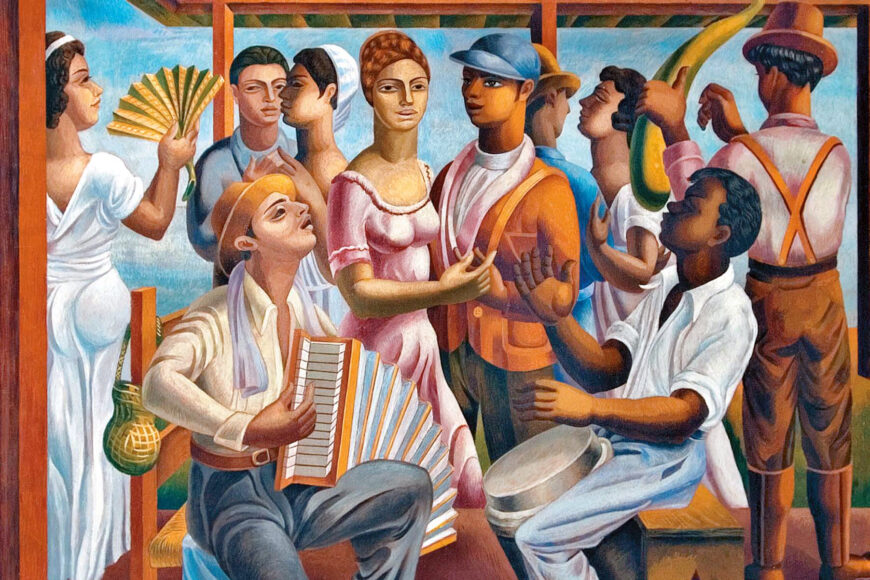Benny Andrews, Flag Day
[0:00] [music]
Dr. Beth Harris: [0:04] We’re standing in the galleries of the Art Institute of Chicago, looking at a painting by Benny Andrews called “Flag Day” that dates to 1966.
Robyn Farrell: [0:15] We see a figure emerging from the American flag. The flag is turned on its side so that the stripes are in a vertical orientation. The figure appears to be grasping two of the stripes.
Dr. Harris: [0:28] It’s hard not to read those stripes of the flag as bars, but it also feels like he’s enveloped in it, and the flag is something reassuring at the same time.
Robyn: [0:41] Another way of reading it which is not as positive is the way in which the flag is almost actually hiding the figure or the figure’s struggling to emerge from these stripes, which of course could be a metaphor for the ways which the African American community is constantly fighting for their own rights or for visibility.
[1:01] And with Benny Andrews in particular, his interest in African Americans being properly promoted within the art world in America.
Dr. Harris: [1:08] Andrews did grow up in a South that was racially segregated. And so this idea of struggling to be seen in America, struggling for one’s rights, these were themes that were incredibly potent in the 1960s.
Robyn: [1:23] Very personal to the artist, who was born in 1930 in Georgia, to parents who were sharecroppers.
Dr. Harris: [1:30] He could only go to school when he wasn’t needed on the farm. Sharecropping is very much what it sounds like. You agree to farm a piece of land for a share in the crops, but the landlord supplies you with everything else. This created a cycle of poverty for so many.
[1:49] At the same time, his identity is more complicated than it sounds at first, since his great-grandfather was a white plantation owner. His grandfather was white. His background is very mixed. We tend to pigeonhole people but things are a lot more complicated.
Robyn: [2:06] I think Andrews really defied categorization in many ways. He spoke about how he didn’t want his art to be only representative of Pop Art or figural. He wanted to be a painter of his time.
Dr. Harris: [2:17] He didn’t want to be pigeonholed as an activist artist either.
Robyn: [2:20] Although “Flag Day,” for example, is not specifically autobiographical, it does represent the larger issues at hand that deal with identity and race. He was mobilized to present work that not only was in some ways hopeful of what the American Dream can mean but also very critical.
[2:38] I think that’s what’s so strong about him and his work is that he was able to address both aspects of being an American.
Dr. Harris: [2:44] We could think about the flag as a symbol of freedom and democracy, but then we would also need to ask, freedom and democracy and equal rights for who?
Robyn: [2:53] Right, and there’s a darker history, and I think that that’s something that Andrews refused to ignore in his work.
Dr. Harris: [3:00] We can see the red and white bars of the flag that part and move to make room for him. There is that sense of attempting to make visible, to be included in history.
Robyn: [3:10] Returning to the idea of the bars, I think that we would be remiss not to mention Benny Andrews’ later involvement with the prison art program, a project that was a part of the organization he co-founded in 1969, the Black Emergency Cultural Coalition, which was a organization of African American artists and creatives — and eventually included white artists as well — that were promoting the presence of African American artists and curators within the art community.
Dr. Harris: [3:42] The problem that arose in 1968, 1969, when the Metropolitan Museum of Art was planning an exhibition called “Harlem On My Mind” that didn’t include the work of a single African American artist. It’s important to put this painting in the context of the civil rights movement.
[3:58] Benny Andrews grew up in the Jim Crow South, with laws that institutionalized segregation, that institutionalized discrimination, and kept people in terrible cycles of poverty. The Civil Rights Act of 1964 and the Voter Rights Act of 1965 did a lot to dismantle the Jim Crow laws that were so oppressive to so many African Americans.
Robyn: [4:22] In 1966, there was the hope that African Americans might gain a more equal place, but at the same time nodding to the fact that the movement hadn’t fully affected every area of culture and society.
Dr. Harris: [4:37] That expression on his face can’t be easily interpreted. It’s not fear, or anger, or complacency, or protest. It’s very hard to locate it.
Robyn: [4:50] I think he’s left it open for interpretation.
Dr. Harris: [4:52] The flag is such a potent symbol in American art history.
Robyn: [4:56] The American flag has always been an important symbol, and I think most popularized by Jasper Johns, the postwar artist who inserted the American flag into his work in the mid to late 50s, which is exactly around the time that Benny Andrews moved to New York. But unlike Johns’ very flat compositions, here, Andrews really enlivens the flag.
[5:18] The stripes have curves. They seem like fabric. The white is not evenly distributed, the stars are unfinished, and so the imperfections of the flag are highlighted here.
Dr. Harris: [5:29] The flag moves here in a way that it doesn’t move in Jasper Johns, the flag [there] is a static symbol.
[5:36] But here, moving with the effect of an African American figure, which does make me think that there is a message of hope in some way that decades of protest and the civil rights movement that America can change for the better and be a place that is more inclusive and that recognizes the civil rights of every citizen.
[5:59] [music]
| Title | Flag Day |
| Artist(s) | Benny Andrews |
| Dates | 1966 |
| Places | North America / United States |
| Period, Culture, Style | Modernisms / Civil Rights era |
| Artwork Type | Painting |
| Material | Canvas, Oil paint |
| Technique |
A short video of Benny Andrews talking about the impossibility of defining Black art
Learn more about this painting at the Art Institute of Chicago
Learn more about Benny Andrews
See primary source and multimedia documents about the Civil Rights Act
See primary source documents about the Voting Rights Act of 1965
What was the impact of the Harlem on My Mind exhibition on the art world?
See primary source documents on the Black Emergency Cultural Coalition
Loading Flickr images...
Test your knowledge with a quiz
Andrews, Flag Day
Key points
- In the 1960s, the Civil Rights movement promised greater equality for African-Americans, who struggled for visibility and equal rights.
- It isn’t clear how Andrews intends us to interpret the relationship between the man and the American flag in this painting. The flag may symbolize the promise of freedom and democracy, or it may suggest that the United States remains a hostile environment for African-Americans.
- The artist’s experience as the son of sharecroppers in Georgia and in the racially-divided New York art world led him to advocate for greater equality in society, as well as within the cultural sector.
More to think about
The 1960s was an era of protest by many different groups, many of which used art in their campaigns. For an artist involved in activist causes, why do you think Benny Andrews left the meaning of Flag Day so unclear?



